My love for eggplant is fierce, pure, and, according to a lot of people, not normal. I don’t get it. At its best, this gorgeous nightshade nothing short of edible silk — what’s not to love about that?
Lots, so I’m told. Put off by Frisbee-sized diner portions of spongy egg-battered eggplant parmesan — or scarred for life by one unbearably bitter mouthful — most people are vehemently anti-eggplant. To make matters worse, the majority eggplant recipes aren’t exactly welcoming: An hour-plus of unnecessary salting, rinsing, draining, and squeezing before you can even cook the damn things is enough to send any sane person elsewhere.
I like to think that if everyone’s first taste of eggplant was in the form of eggplant caviar — ikra baklazhana in Russian, which is where it originated — more people would feel the way I do. This is what eggplant should be: roasted whole until very soft, then slowly braised in olive oil, with minced onions, bell pepper, tomatoes, honey, and an ungodly amount of garlic. The result is a savoury-sweet, lusciously rich spread that’s hard not to eat straight from the pan with a spoon. It’s not a fast recipe by any means, but there’s zero eggplant coddling required. If you can dice an onion, you can make eggplant caviar.
Traditionally you’d serve eggplant caviar on toast points or crackers as part of an appetizer spread, but like any great condiment, there’s not much it doesn’t improve. Sandwiches and scrambled eggs are obvious pairings, but try it on grilled meats, roasted vegetables, hot buttered rice, or as a base for mayo-less pasta salads. For me though, tomatoey, garlicky braised eggplant begs for potatoes—fried ones, if at all possible. Since eggplant caviar isn’t what you’d call photogenic, I made some super-crispy roasted potatoes, dolloped warmed-up caviar over top, and added mayo and a crispy egg for a patatas bravas-adjacent situation. It was just as delicious as it sounds—and easy on the eyes to boot.
Eggplant fiends have probably scrolled to the recipe already, but if you’re on the fence, consider this: all of the main ingredients are either peaking right now or on their way out of season, so eggplant caviar is an excellent way to demolish a mountain of late-summer produce. It’s also easier, tastier, and more versatile than ratatouille.
Eggplant Caviar
As written, this should yield about three cups, but the quantities are more suggestion than rule; use whatever you have and season the whole mess to taste. Any extras will freeze (or can) very nicely. Start-to-finish, this will take about three hours, but most of it is hands-off.
Ingredients:
-
2 pounds eggplant (two medium-sized ones should do it)
-
Up to ¼ cup olive oil
-
2 medium yellow onions, finely chopped
-
1 green bell pepper, finely chopped
-
4 cloves of garlic, minced
-
3 large tomatoes, finely chopped
-
1-2 teaspoons honey
-
Zest and juice of half a lemon
-
(Optional) Cayenne or other ground hot pepper, to taste
-
Salt and pepper, to taste
Instructions:
Heat oven to 205C. Place whole eggplants on a baking sheet lined with parchment or foil, transfer to the oven, and bake until very soft. Check on them after 30 minutes to see how things are going; depending on the size and number of the eggplants you’re using, this step will take between 40 and 90 minutes. (Alternatively, heat a gas or charcoal grill to medium hot and grill the eggplants whole until they soften.)
Meanwhile, heat the oil in a large, wide pan with a lid over medium-low heat. You want just enough oil to barely coat the bottom of the pan, which for me was a scant quarter cup. Add the onions and a big pinch of salt and cook for 15 to 20 minutes, until very soft. Add the pepper and garlic and cook for another 15 to 20 minutes, stirring only as needed. (If the onion and pepper mixture finishes cooking before the eggplants, no big deal—just cut the heat and let the pan stand until you’re ready to continue.)
When the eggplants are super soft, transfer them to a bowl or plate to cool. When you can safely handle them, cut the eggplants open lengthwise and scoop every last bit of the cooked flesh into the pan with the onion and pepper mixture. Add the tomatoes, honey, and another big pinch of salt and bring the mixture to a boil over high heat. Reduce heat to low, cover the pan, and simmer for an hour.
At this point, your eggplant caviar will be soft and spreadable, but quite watery. Take the lid off, crank up the heat, and cook until most of the liquid has evaporated. This will take about 20 to 30 minutes; stay nearby and stir frequently to avoid scorching the bottom.
You should now have a pan full of thick, velvety, ragú-like eggplant caviar. Stir in the lemon zest and juice, then have a taste and add more salt and honey if needed (I find it usually needs more of both), plus as much ground hot pepper as you like. This is a condiment, so season accordingly: it should be primarily rich and sweet, but with plenty of saltiness and acidity for balance.
Cool the caviar to room temperature before transferring to a storage container. Mass-produced eggplant caviar is sold in glass jars, so this stuff is a great candidate for canning, but it also keeps indefinitely in the freezer. If you store it in the fridge, try to eat it within a month. I know, I know, it’s a big ask—but I believe in you.

Comments